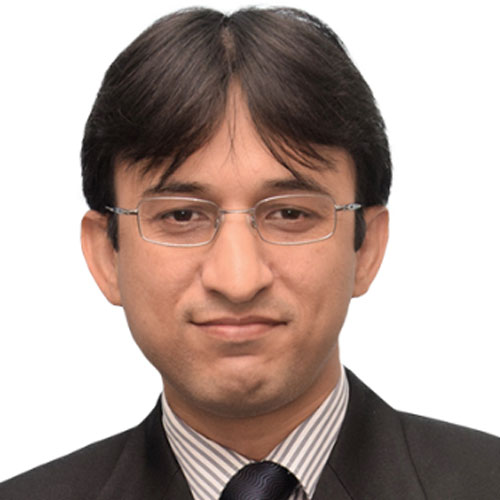
Mr. Umesh Sharma
Vice President & Portfolio Manager – Fixed Income, Franklin Templeton India
Umesh Sharma is a vice president and portfolio manager for Franklin Templeton Fixed Income in Mumbai, India. Mr. Sharma is responsible for managing local fixed income portfolios focusing on high grade debt, closed ended scheme, and debt portion of hybrid schemes.
Mr. Sharma has over 20 years of experience in the financial services industry. Prior to his current role, Mr. Sharma was a fund manager for Religare Asset Management Company Pvt. Ltd. He also was previously with ICICI Bank, JM Financial Asset Management Company Pvt. Ltd., and UIT Asset Management Company Pvt. Ltd. Mr. Sharma joined Franklin Templeton in 2010.
Mr. Sharma holds a bachelor of commerce from Mohanlal Sukhadia University at Udaipur. He is a Chartered Accountant (Institute of Chartered Accountants of India) and a Company Secretary (Institute of Company Secretaries of India). He also finished level III for the CFA (CFA Institute, USA) in 2006.
1. If one evaluates that the interest rate hike is about to reach its pinnacle, what kind of investing strategy will you suggest to retail investors?
In an ideal situation, the yield curve plotted as a function of tenure and yields is an upward sloping figure. This denotes commensurately higher interest rates for higher duration. It must also be noted that in fixed income market interest rates and price of a debt security move in opposite direction. Considering that the interest rates are about to peak, one may look at investing in funds that have longer duration. However, much also depends on other factors such as risk appetite of investor, liquidity, investment goal, among others. For an investor with multiple goals, a ladder approach may be handy where goal-specific investment can be made in funds that match the goal horizon i.e. funds that have a defined maturity date. Alternatively, a simple solution would be to invest the contingency corpus in liquid or money market funds and for investment horizon of two years and above a medium duration product may be considered.
2. It is generally difficult to predict the numbers announced by the Fed, RBI and other authorities. Even if we read analysis from economists it is still difficult to analyze the debt markets. Can you suggest some simple ways that would help investors to understand the key drivers of the debt market?
Simply put, the key drivers of interest rates are growth, inflation and external dynamics. In India, RBI, being an inflation targeting Central Bank, looks at its inflation target of 4%+/-2%, while keeping an eye on growth. Thus, if inflation is expected to breach the target, then it is imperative for RBI to act.
Thus, in very simple terms, if growth parameters are satisfactory and inflation is under control, then expect a stable rate regime. If growth is accelerating and inflation is likely to breach the target, then expect a rising rate regime and if growth is slowing and inflation is weakening, then expect a downward trend in rates. One must remember that markets are forward looking and are typically discounting expectations with respect to these variables. Hence, one may find opportunities if one’s analyses is different from what the market has baked in.
3. What are the red flags while evaluating the liquidity of your portfolio, and what do you do when you encounter these warning signs?
We evaluate the portfolio daily with respect to underlying liquidity. The fixed income portfolios have a significant exposure (minimum 80%) to highest rated securities which are typically liquid. We also closely track the flows into/out of the funds and any concentration risks there. We also evaluate the flow into/out of the industry within similar funds. In addition, the news flow with respect to portfolio exposures is closely monitored. There is an independent risk management function which also tracks these liquidity parameters and in addition, also looks at portfolio liquidity with respect to historical redemption trends etc, among other things. The framework ensures that the funds keep aligning to changes in the external environment on a dynamic basis.
4. What kind of impact could tax amendments on debt funds have on investor participation? Do you believe that in order to encourage investor engagement, recent changes will necessitate significant product modifications?
Going by the recent data from AMFI, we haven’t seen much impact. On a YTD basis, fixed income category AUM has grown by 14%, folios have also grown by 0.25% in line with trend from previous months. Debt funds continue to offer benefits over traditional investments in the form of choices depending upon risk-return appetite, ability of schemes to reflect prevailing interest rates through portfolio yield to maturity, professional management, option to redeem investment without penalty, among others. There are certain taxation benefits also like deferment of taxation, adjustment of capital gains/losses etc.
Current regulations do not permit excessive modifications in product structures. We feel the current set of 16 funds category offer a plethora of investment solutions to investors. Beyond these, there are Fixed Maturity Plans and Target Maturity Funds as well which serve well to meet varied investor requirement.
5. How much AUM do you manage, and can you provide us an overview of the last three years' performance of the funds you directly manage?
I manage/co-manage around $1 billion AUM across fixed income and hybrid schemes. For the funds I directly manage, 67% of the funds have been in the top 2 quartiles over a 3-year time frame (regular plans; data as of 23th Jun 2023), while the balance have slight underperformance relative to peer average.
6. What’s your investment mantra and how well has it worked for you?
On the professional front, the investment mantra is to look at the data hard, glean information and use it to distill into portfolio construction. In other words, its research, conviction, and execution.
On the personal front, the mantra is to invest for the long term while keeping overall asset allocation as per my goals. One should not be deterred by short-term fluctuations and should keep an eye on the long-term.
